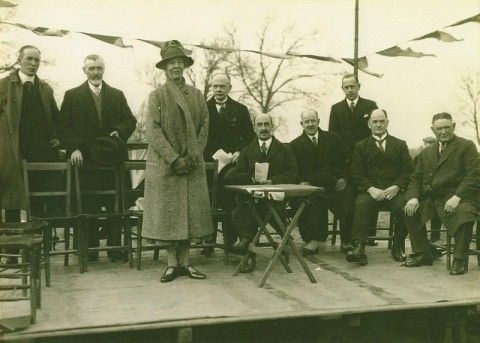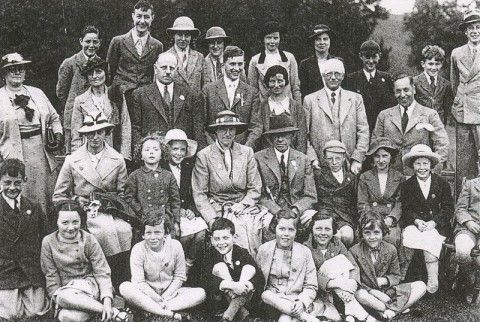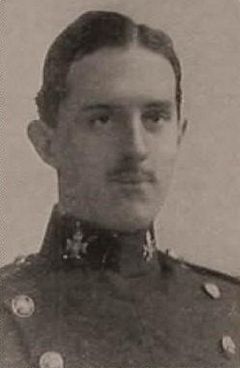The Milners at Totley Hall & Gillfield Wood
by Josie Dunsmore
After the long period of tenancy under the Coke family at Totley Hall and the short ownership of John Unwin Wing (1881-82) and William Kent Marples (1882-83) Totley Hall entered the longest settled period of living-in ownership in its whole life. William Aldam Milner and his wife, Sarah Elizabeth (known as Elsie) had only been married a year when the Hall was purchased for them by father William Pashley Milner, who rented Meersbrook Hall and so would have no property to leave his son. He died in October 1884 having seen his son and family settled in the Hall just in time for Marjorie Elsie, the first grandchild to be born. The Hall had been left in a good state of repair by Wm Marples so the family were able to settle there comfortably. William Alfred (Billy) was born in 1888 and Roy Pashley in 1892. Wm. A. Milner had a lodge built for his coachman in Totley Hall Lane in 1887, but it wasn’t until after Roy was born that they felt a need to have more room in the house for entertaining and guest accommodation.
In 1893 the Milners began to further extend the Hall by adding a new wing. They used the same architect, J. D. Webster, that W. K. Marples had used ten years previously. His drawing still survives in Matlock archives, dated 1892, and shows the turret room and the front windows complimenting those of the 1883 additions. A new billiard room was added as well as additional rooms for entertaining and below stairs rooms for the servants.

Sarah Milner opening Totley Recreation Ground, 1929
The Milners became to all intents and purposes the Squires of Totley. Sarah Milner was involved in serving on local community committees, attending local events, presenting prizes and supporting charities, while Mr Milner, a Cambridge graduate and qualified lawyer who never practised, served in roles at county level. Both the Milners enjoyed the life of a country gentleman and his lady. They lavished money on their home and gardens, and changed Gillfield Wood from being a useful commodity to the community, as well as being a money earner, to being a Victorian family’s private playground.
W. A. Milner enjoyed fishing in Totley Brook in Gillfield Wood, where brown trout were the main catch. G. H. B. Ward records several instances when brown trout were present in the Brook. In 1887, Mr R. J. Youle, a visitor to Holmesfield, mentioned seeing trout, and in 1897 George Beresford and employer George Crawshaw caught 79 trout to stock a pond at Storth House. There are reports of trout in the stream in the 1940s and 1950s and some are still to be seen today.

Site of Shooting Lodge (photo: Bob Warburton, c. 1970)
Shooting pheasants in Gillfield Wood was another pastime enjoyed by Mr Milner. In this he was ably assisted by his gamekeeper, Mr Arthur Bradley, who was also his right hand man. Mr Milner had a “stone built charcoal burner’s hut in the wood converted into a hunting lodge”, said granddaughter Elsie Wilson in 1970. This ‘lodge’ was a dug out below ground, stone lined and roofed in stone, and was in a larch copse near the Totley to Storth House footpath. Local men interviewed by Bob Warburton in 1975 identified its situation on a map and remember it as a “shooting lodge”. They described shooting parties organised by Mr Milner, who used to have picnics there. It was apparently equipped with a stove for brewing a drink. When measured by Bob in 1974 the lodge was 8 ft long and 5 ft wide. Local men, including Frank Taylor and Sid Andrews, said this lodge had “always been there”. As yet (2013) there is no archaeological evidence that this was a charcoal burners’ hut, but there is evidence of charcoal burning in Gillfield Wood, so it is not impossible that there is some truth in this family legend. The building is now in ruin with only bits of the walls remaining. However, these show that the hut was well built.

Gamekeeper's Hut (photo: Bob Warburton, c. 1970)
A second dug out stone-lined structure, almost identical in style to the “Shooting Lodge” but smaller (2 ft 6 in by 4 ft in 1970), was in Pheasant Wood. This wood was cordoned off by barbed wire and used for rearing pheasants for Milner’s parties to shoot. Mr Arthur Bradley was the last full-time gamekeeper in Totley. He put rails in the trees for pheasants to use as roosts and kept food for the birds, including nuts and raisins in his dug out “shed”. Local boys such as Frank Taylor and Archie Thomas and friends made sure that the food didn’t always reach the pheasants, as they raided “Old Bradley’s Shed”. By the 1970s there were no pheasants in the area, and the “Shed” was being used as a den by local lads, though Pheasant Wood was still fenced off from the rest of the wood at that time.

The Barlow Hounds hunting along the edge of Monk Wood c. 1946. Elsie Wilson (right) , Hunstman Bill Spry and Anne Wilson
Gillfield Wood was a favourite spot for the whole Milner family, who would take picnic lunches there or exercise their horses in the wood. Horse riding was a favourite pastime of the Milners and their three children, who rode with their friends the Wilsons of Beauchief Hall. “Gillfield Wood and surrounding district would often echo to the sound of the hunting horn of Barlow Hunt,” remembered their granddaughters, Elsie and Anne Wilson of Horsleygate in 1970. This memory of the Hunt is reinforced by an item in the Derbyshire Times dated 23 March 1889, which reported a ‘splendid run’ with Barlow Hounds on Tuesday with Mr W. Wilson of Beauchief Hall as Master.
Derbyshire Times, Saturday 23 March, 1889
HOLMESFIELD
SPLENDID RUN WITH THE BASLOW HOUNDS
On Tuesday these well-known hounds met at Cowley Bar, Holmesfield, at 10 a.m. under the owner and mastership of W. Wilson, Esq., of Beauchief Hall, who was present, as was also the well-known whip, W. Haslam, of Milnthorpe. A start was made to Holmesfield Park, which was found blank. The hounds were next taken to the Burrows Wood, near Barlow, where Reynard was quickly found, and dashed off at a tremendous speed to Rosewood, the hounds following in quick pursuit, and went round the Rose Wood three times in succession. A start was again made, Reynard leaving the wood made for Horsley Gate Hall, then to Lidgate, across to Holmesfield Park, turning up the wood in the direction of Holmesfield village, where he made a sharp turn crossing the fields to Mickley, then by Totley Orphanage to Gill Field wood to near Storth House, turning sharply round he made back to Gill Field wood, the hounds closely following him. The fox left the wood and made to Totley brickyard, where he came to grief and was killed by the hounds after one hour and fifty minutes splendid and exciting chase. The hounds scarcely lost sight of him during the time. The owner, W. Wilson, Esq., took Reynard’s head, and the brush was handed to Mr. A. T. H. Barnes.
Another leisure activity the Milners enjoyed in Gillfield Wood was swimming. Mr Percy Earl, superintendent of Totley Hall in 1971 when it was a College of Education, told history student Patricia Hall that “his father had helped to dig out the foundations of a swimming pool in Totley Brook in Gillfield Wood in the early 1900s”. This was filled through a channel from Totley Brook and was meant to be a private pool, but there was at least one incident of trespassing, cheerfully admitted by Mr. Grayson of Brook Hall (in 1971), who with his friend, son of Judge Ellison of Totley Grove, was enjoying an early morning dip only to be discovered by William Aldam Milner, who reprimanded them but softened the effect by inviting them to breakfast at Totley Hall. The pool has been re-excavated on a few occasions – at least twice before 1970 – as it silts up quickly. Jean Smithson and Archie Thomas have memories of it being cleared by local lads who got filthy. On the 1922 OS map the swimming pool is seen as an oblong shape, but the 1959 OS map shows it had degenerated to a “POND”. A large depression near Totley Brook with a silted up leat are all that remains of this pool.
Gillfield Wood was also a place of romance. At the age of sixteen Marjorie, the only daughter of the Milners, became fond of William Wilson, who, in 1900, became Master of Barlow Hounds. Her parents had greater ambitions for their daughter as well as not approving of the relationship as she was so young. The couple flouted parental disapproval and met secretly in Gillfield Wood whenever they could. Eventually in 1909 Mr Milner gave consent to their marriage, and after a big celebration the couple set up home in Horsleygate. The photograph below shows William and Marjorie Wilson, seated centre, about 30 years later.

Barlow Hunt Pony Club summer meeting at Horsleygate, 1938
William Aldam Milner, J.P. and Chairman of many committees, was appointed High Sheriff of Derbyshire in 1911. He and his wife were keen gardeners and raised new varieties of several plants, including a polyanthus primula and an unusual cactus. Their elder son, William, also qualified as a lawyer but never practised, and married local colliery manager’s daughter, Beatrix Ronksley. He served throughout the 1st World War as a lieutenant, but their younger son, Roy Denzil, was killed after only six weeks at the front. The grieving Milners bought land for the Parish Church to be built and contributed extensively to the building fund in memory of Roy.

Roy Denzil Pashley Milner
Mr Milner retired from public life in 1925, but continued to enjoy his house, garden and wood, despite being mostly confined to a wheelchair and in great pain. He died on 24 January 1931, age 76, and is buried in Holmesfield Churchyard. Soon after his death his wife moved to Baslow and leased the Hall to the Cutlers Company. It was the end of an era for the community. Colonel Tozer, (1897 – 1971), Master Cutler, lived at Totley Hall but never had the same standing as the Milners though he was well liked and respected.
Mrs Milner died in 1944, but the sale of Totley Hall was deferred, by her will, until the end of the 2nd World War when, in 1945, it was sold to Sheffield Corporation. It became a Housecraft Training College in 1949 and was vastly extended in 1962 when it became a College of Education. In 1971 it amalgamated with Thornbridge College.
Josie Dunsmore
Updated September 2021
